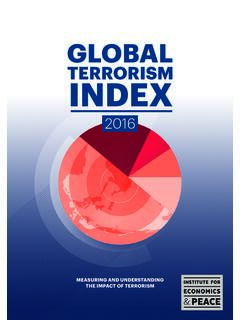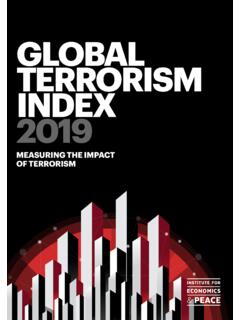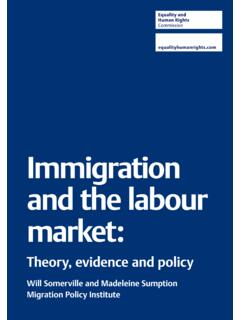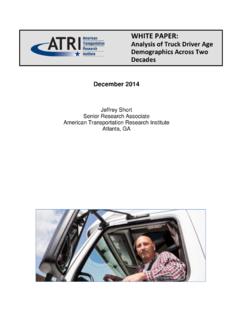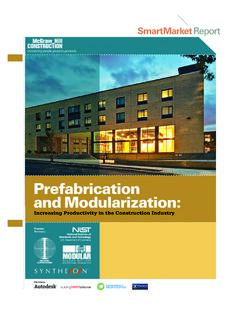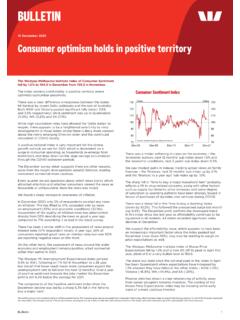Transcription of GLOBAL PEACE - Institute for Economics & Peace
1 Institute for Economics & PeaceMeasuring PEACE in a complex worldGLOBAL PEACE INDEX GLOBAL PEACE INDEX 20202021 Quantifying PEACE and its BenefitsThe Institute for Economics & PEACE (IEP) is an independent, non-partisan, non-profit think tank dedicated to shifting the world s focus to PEACE as a positive, achievable, and tangible measure of human well-being and achieves its goals by developing new conceptual frameworks to define peacefulness; providing metrics for measuring PEACE ; and uncovering the relationships between business, PEACE and prosperity as well as promoting a better understanding of the cultural, economic and political factors that create is headquartered in Sydney, with offices in New York, The Hague, Mexico City, Brussels and Harare.
2 It works with a wide range of partners internationally and collaborates with intergovernmental organisations on measuring and communicating the economic value of more information visit cite this report as: Institute for Economics & PEACE . GLOBAL PEACE Index 2021: Measuring PEACE in a Complex World, Sydney, June 2021. Available from: (accessed Date Month Year). GLOBAL PEACE INDEX 2021 | 1 Section 2: Trends 29 GPI Trends 30 Domain Trends 32 Section 1: Results 6 Highlights 72021 GLOBAL PEACE Index Rankings 9 Regional Overview 14 Improvements and Deteriorations 21 The Impact of the COVID-19 Pandemic on PEACE 25234651 Executive Summary 2 Key Findings 4 ContentsSection 4.
3 PEACE and Perceptions of Risk 49 Introduction 50 Perceptions by Government Type 53 Perceptions by Region 56 Section 6: Appendices 73 Appendix A: GPI Methodology 74 Appendix B: GPI Indicator Sources, Definitions & Scoring Criteria 78 Appendix C: GPI Domain Scores 86 Appendix D: economic Cost of Violence 89 Endnotes 92 Section 5: Positive PEACE 60 What is Positive PEACE ?
4 61 Positive PEACE and the GPI 63 Positive PEACE as a Predictor of economic Outperformance 71 Section 3: The economic Impact of Violence 37 Highlights 37 The economic Value of PEACE 2020 38 Methodology at a Glance 47 GLOBAL PEACE INDEX 2021 | 2 EXECUTIVE SUMMARYThis is the 15th edition of the GLOBAL PEACE Index (GPI), which ranks 163 independent states and territories according to their level of peacefulness.
5 Produced by the Institute for Economics and PEACE (IEP), the GPI is the world s leading measure of GLOBAL peacefulness. This report presents the most comprehensive data-driven analysis to-date on trends in PEACE , its economic value, and how to develop peaceful societies. The GPI covers per cent of the world s population, using 23 qualitative and quantitative indicators from highly respected sources, and measures the state of PEACE across three domains: the level of Societal Safety and Security, the extent of Ongoing Domestic and International Conflict, and the degree of Militarisation.
6 This year s results show that the average level of GLOBAL peacefulness deteriorated by per cent. This is the ninth deterioration in peacefulness in the last thirteen years, with 87 countries improving, and 73 recording deteriorations; however, the change in score is the second smallest in the history of the index. The 2021 GPI reveals a world in which the conflicts and crises that emerged in the past decade have begun to abate, only to be replaced with a new wave of tension and uncertainty as a result of the COVID-19 pandemic and rising tensions between many of the major full impact of the COVID-19 pandemic on peacefulness is still unfolding.
7 While some forms of violence declined in the short term, growing unease with lockdowns and rising economic uncertainty resulted in civil unrest increasing in 2020. Over 5,000 pandemic-related violent events were recorded between January 2020 and April 2021. It is still too early to fully gauge the long-term effects of the pandemic on PEACE . However, the changing economic conditions in many nations increases the likelihood of political instability and violent remains the most peaceful country in the world, a position it has held since 2008.
8 It is joined at the top of the index by New Zealand, Denmark, Portugal, and Slovenia. Afghanistan is the least peaceful country in the world for the fourth consecutive year, followed by Yemen, Syria, South Sudan, and Iraq. All, except Yemen, have been ranked amongst the five least peaceful nations since at least 2015, with Afghanistan having been ranked amongst the three least peaceful nations since 2010. Eight of the ten countries at the top of the GPI are located in Europe. This is the most European countries to be ranked in the top ten in the history of the index.
9 Singapore fell out of the top ten, replaced by Ireland which improved by three three of the nine regions in the world became more peaceful over the past year. The largest improvement occurred in the Middle East and North Africa (MENA), followed by Europe and South Asia. However, MENA still remains the least peaceful region in the world. An improvement in the level of Ongoing Conflict in MENA was the biggest driver of increased peacefulness, with every indicator on the domain, recording an improvement.
10 In Europe the improvement in peacefulness was driven by improvements in internal safety and security, including improvements in terrorism impact, violent demonstrations and violent crime. However, political instability and military expenditure largest regional deterioration occurred in North America, which deteriorated across all three GPI domains. The primary driver of this fall in peacefulness was a deterioration on the Safety and Security domain, especially in the United States, where growing civil unrest led to increasing perceptions of criminality and political instability, and more violent demonstrations.

